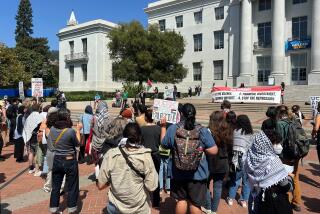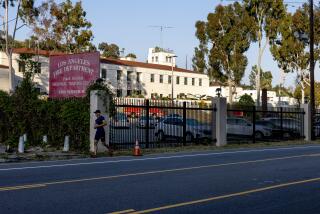From War to Peace : As Army Sounds Retreat From Ft. Ord, Base Finds New Life as CSU Campus
- Share via
FT. ORD, Calif. — The barracks are empty, the windows boarded up. The soldiers have vanished, leaving a legacy of swords, daggers and snakes painted on the buildings they once occupied.
“Think War,” says a mural adorning one wall.
Soon, a different breed of thinker will take command of this sprawling Army base just north of Monterey.
By the fall of 1995, Ft. Ord will be transformed into California State University Monterey Bay, the 21st campus in the state university system.
Army barracks will be reborn as classrooms and dormitories, mess halls will become dining commons, and the soldiers’ sports club will be turned into a student union. Someday, the campus will hold as many as 25,000 students.
“It used to be we were educating people to survive war,” said Hank Hendrickson, a former Ft. Ord garrison commander who is executive dean of the new university. “Now we’re going to be educating people to survive the 21st Century.”
At a time when the university system is retrenching and budget cuts have forced a decline in enrollment, the Monterey Bay campus stands out as an ambitious bid for expansion. And with military facilities slated for closure nationwide, 77-year-old Ft. Ord has become a model for the quick conversion of bases to civilian use.
With unemployment running as high as 13% on the Monterey Peninsula since the Army began pulling out, community leaders hope the new campus will continue the transformation of the region into a scientific research center. The area boasts 16 marine research institutes and the newly created Monterey Bay National Marine Sanctuary offshore.
Officials say they want to create an innovative campus with an emphasis on new technology, including a library system linked by computer to other universities. A new University of California graduate center focusing on environmental research will be established on a section of the base next to the CSU campus. University planners hope to forge close ties with the nearby marine research centers and the Defense Language Institute.
“We will become the Silicon Valley of the sea,” said Rep. Sam Farr (D-Carmel), who has helped push for creation of the campus. “We have been able to create not only a reuse of Ft. Ord but also our own economic identity.”
For CSU, the new campus is a bargain.
Chancellor Barry Munitz estimates the university system is receiving an asset worth $1.2 billion at a time when it does not have the resources to maintain its programs, much less build a university.
“I’m very pleased,” the chancellor said. “When so much of our news is depressing, this is a quite miraculous bright spot.”
The federal government is expected to pay most of the $150-million cost of converting the buildings for civilian use, including seismic upgrading and access for the disabled.
Munitz acknowledged that students at other campuses where classes have been cut back are worried that money will be diverted to pay for Monterey Bay. But the chancellor pledged that he will “do everything possible” to keep that from happening.
One proposal is to charge higher tuition at the new campus, he said. CSU is considering a two-tier system where higher fees would be charged at popular campuses, such as Humboldt State, Sonoma State and Cal Poly San Luis Obispo. Monterey Bay may also create a service component, with students providing construction labor in exchange for tuition credits.
“The hope is that the campus will pay for itself,” he said.
Although budget problems have forced the university system to cut back, state projections show that it will have to grow from 326,000 students today to at least 486,000 students by 2010 to keep pace with the state’s population growth.
The Monterey Bay campus will start small--with no more than 2,000 students its first year--and grow steadily as barracks, administration buildings and other facilities are converted to civilian use. It would reach its maximum capacity of 25,000 after 2020.
Munitz said there is no question that the campus--a short distance from the ocean and close to the cities of Monterey and Carmel--will be a popular place: CSU has received 2,000 unsolicited applications from professors seeking jobs.
The campus will be in the heart of Ft. Ord, taking over dozens of barracks, administration buildings, an 8,000-seat stadium, a well-equipped gym, a church, bowling alley, medical clinic and a subdivision with 1,253 homes. Altogether, the university will receive nearly 1,400 acres with 4.4 million square feet of developed space.
Given its funding shortage, CSU does not plan to build the kind of large library found at most universities. Instead, the campus will establish three or four smaller buildings as libraries with electronic links to other universities.
While CSU will serve as the core of the civilian Ft. Ord, the rest of the 28,000-acre base will be divided among a variety of purposes.
In addition to the land for a research center, UC will take over a toxic landfill and turn it into a research laboratory on waste disposal. Other universities and schools will get chunks of the base.
Former military housing will be converted into homes for about 250 homeless people. The nearby city of Marina will take over the base airfield for a municipal airport.
About 3,000 acres will be available for private commercial development within the overlapping cities of Marina and Seaside. The Army will keep about 2,000 acres for its Presidio of Monterey Annex to provide housing for military personnel stationed in the area.
But more than half of Ft. Ord--16,000 acres in all--will be set aside as a land preserve--largely because unexploded bombs and buried ammunition make much of the land unusable.
Ft. Ord was established during World War I and rose to prominence during World War II, when it became one of the nation’s largest Army training bases. It also served as a major training base for the Korean and Vietnam wars.
In 1972, the base became home for the 7th Infantry Division and barracks were built to serve the new, more particular volunteer Army. After the Pentagon’s 1991 decision to close Ft. Ord, the 7th Infantry Division was disbanded.
At first, the Army balked at turning the base over to civilians. Soldiers began stripping the post of virtually all hardware, tearing sprinklers out of the ground and hauling pews out of the church.
After members of the community and Congress protested, the Army retreated and adopted a more cooperative approach.
“That was a good example of how not to do business,” said Col. Tom Ellzey, who was brought in as garrison commander after the incident. “Every person in the Army has been brought up to build things. No one has been trained in how to divest land we’ve occupied for years.”
Today, base officials say their primary mission at Ft. Ord is to help the Monterey region.
“Ft. Ord realized the bottom line was not the Army’s concerns but the community,” Ellzey said. “Our goal is to provide the facilities and get on with business and start rebuilding the economy of the Monterey Peninsula.”
Now, he said, the conversion is proceeding at a faster pace than at other Army bases. On July 8, Defense Secretary William Perry--a former university professor--will come to Ft. Ord to give the university title to the new campus.
At the beginning of last year, more than 15,000 troops were based at Ft. Ord. Now, there are only 250 soldiers left. In September, the base will officially be shut down.
“To me, it’s pure success that nobody’s here,” said Ellzey, who will retire in January after 27 years in the Army. “That’s the job I was given to do.”
Plan for Peacetime
Ft. Ord, about 100 miles south of San Francisco, began to play a major role in U.S. military operations during World War II. Encompassing 44 square miles, much of the Army base is being turned over to the California State University system for a new campus.
Highlights in Ft. Ord history:
* Named in honor of Maj. Gen. Edward Ord, who served at the Presidio of Monterey and later commanded Union troops in the Civil War, Camp Ord was established in 1917 as a maneuver area and field artillery range.
* During World War II, it was a major staging area for units being deployed to the Pacific theater. At the war’s peak, it housed more than 50,000 troops.
* In the early 1950s, troops trained at there for the Korean War. The first permanent barracks were built.
* During the 1960s, the fort was a major staging area for troops going to Southeast Asia.
* In 1972, it became the home station for the 7th Infantry Division, which remained at the fort until the fall of 1993.
Sources: Ft. Ord Reuse Group and California State University
More to Read
Sign up for Essential California
The most important California stories and recommendations in your inbox every morning.
You may occasionally receive promotional content from the Los Angeles Times.













